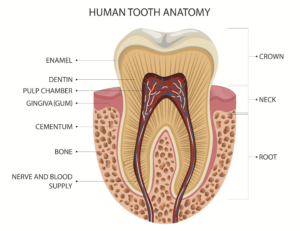- Enamel: This is the outermost layer of the tooth and is the hardest substance in the human body. Enamel is translucent and acts as a protective shield for the underlying layers of the tooth. It helps to withstand the forces of chewing and biting.
- Dentin: This is beneath the tooth enamel; dentin makes up the bulk of the tooth structure. It is a yellowish substance that is softer than enamel but still quite strong. Dentin contains tiny channels called dentinal tubules that transmit sensations, such as hot or cold, to the innermost part of the tooth.
- Pulp: The pulp is the innermost part of the tooth in the pulp chamber and root canals. It consists of connective tissue, blood vessels, nerves, and cells. The pulp nourishes the tooth during its development, but once the tooth fully forms, it can survive without the pulp.
- Cementum: Cementum covers the root surface of the tooth and helps anchor it to the surrounding bone via periodontal ligaments. It is not as hard as enamel but provides essential support for the tooth.
- Periodontal Ligament: This is a thin layer of fibrous tissue that connects the tooth to the surrounding bone in the jaw. It helps to absorb forces during chewing and provides stability to the tooth within the socket.
- Root Canal: The root canal is a space within the tooth that contains the pulp tissue. It extends from the pulp chamber in the crown down to the root tips.
Understanding the anatomy of a tooth helps us appreciate its complexity and the importance of maintaining proper oral hygiene. Regular dental care and hygiene practices are essential to keep each layer of the tooth healthy and functioning optimally.
The Procedure
During the root canal, your Dentist will start by numbing the area with local anesthesia to ensure comfort. Next, they will create a small access hole in the tooth, providing access to the pulp chamber and root canals. Using dental tools, the Dentist will remove the infected pulp, clean up the canals, and shape the canals. Once the canal is clean, the Dentist will fill it with biocompatible gutta-percha material and seal it off. Finally, a dental crown or filling may be placed on the tooth to restore its strength and protect it from further damage.
For the root canal treatment (patient education video), please click on the link.
Saving the Tooth
A root canal is often the last opportunity to save a tooth that would otherwise need tooth extraction. By removing the infected pulp and sealing the canals, the root canal procedure eliminates the source of infection, preventing it from spreading to other teeth or causing more significant health issues.
Benefits of Saving Your Natural Tooth
Preserving your natural tooth through a root canal offers several advantages. Firstly, it helps maintain proper chewing function and bite alignment. It also prevents neighboring teeth from shifting and potentially causing misalignment or bite problems. Additionally, keeping your natural tooth avoids needing more extensive and expensive dental treatments, such as dental implants or bridges, after the tooth extraction.
Tooth Restoration
Following a root canal, your Dentist may recommend placing a dental crown or filling on the treated tooth to provide strength and protection. This restoration helps restore the tooth’s appearance, functionality, and durability, allowing it to function like any other healthy tooth in your mouth.
Long-Term Success
A root canal has a high success rate when performed correctly and when the tooth receives proper care afterward. Maintaining good oral hygiene, regular dental check-ups, and following your Dentist’s instructions will help ensure the long-term success of the root canal treatment.
Conclusion
Root canal is a highly effective procedure that can save your natural tooth by removing infected or damaged pulp, eliminating pain, and preventing further dental issues. By preserving your tooth, a root canal allows you to maintain proper oral function, prevent additional dental problems, and avoid more complex and costly treatments. It’s always best to consult your Dentist, who can provide personalized advice based on your specific dental condition.


